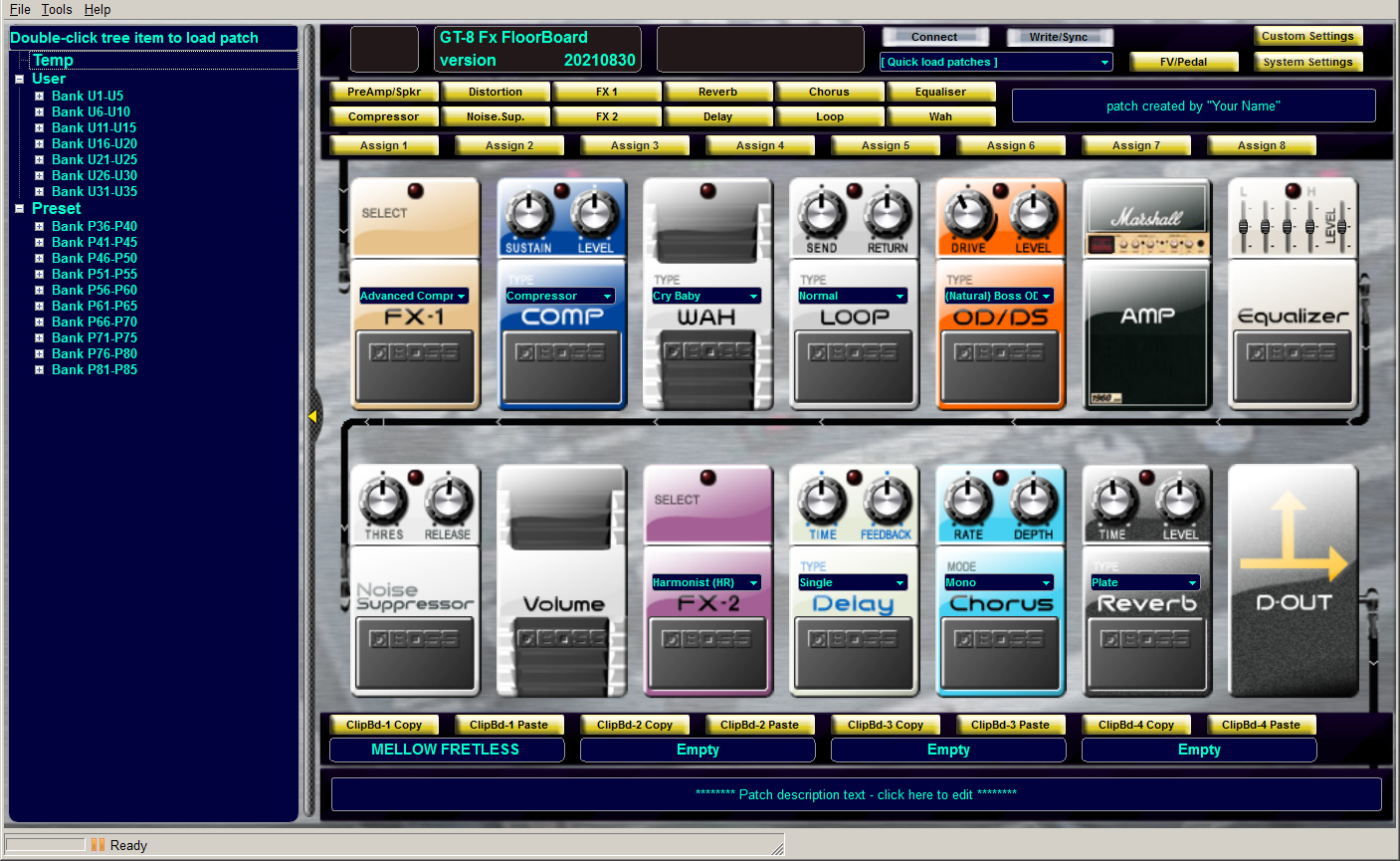Creating and editing patches on the GT-8 itself can be cumbersome. It’s a lot easier to navigate the GT-8 by connecting it to a PC (MIDI) and using software to edit your parameters. This is especially useful when naming patches, as you can simply type in the names without scrolling through a stream of characters. You can also save patches to a file, which is then interchangeable between GT-8 users.
Fx FloorBoard is compatible with a variety of legacy Boss products. It offers a straight forward graphical user interface, providing an immediate overview of your signal path:
To get connected, you will need to use both MIDI ports (in and out) at the back of the GT-8. This connects directly to your audio interface. I like to use a combined MIDI cable, which offers dual MIDI ports using the same cable. If you don’t have an audio interface, or your interface doesn’t support MIDI, it’s possible to use a MIDI to USB adapter cable. Not all USB to MIDI cables are compatible with the GT-8. Roland manufactures their own adapter which is recommended for use with Boss products, called the Roland UM-ONE-MK2.
Note: The GT-8 contains various MIDI settings which are accessible by pressing SYSTEM. None of these settings, however, affect the PC editor. The “PC OUT” parameter stands for “program change,” which sends a MIDI message each time you change a patch.
To set Fx FloorBoard to use your MIDI device, select Tools > Preferences > MIDI. The software should connect automatically if your MIDI connections are correct, however you can also use the “Connect” button. The connection status is indicated at the bottom left of the window.
To begin editing, simply drag the pedals around to create your own custom signal path. Double click on a pedal to change its parameters, and turn the effect ON or OFF by clicking once inside the grey area at the bottom of each pedal. You can change the name of the patch by double-clicking the light blue text at the top of the window.
The “Write/Sync” button doesn’t have any function – perhaps due to a compatibility issue with more recent releases of Windows. This button is meant to synchronize the GT-8 with the settings defined in Fx Floorboard if “Temp Buffer” is displayed. Otherwise it’s meant to perform a WRITE function to save your settings. This feature doesn’t work, so you will need to use the WRITE function on the GT-8 itself.
Fx Floorboard features a clipboard for quickly managing and recalling settings. There are 4 individual clipboards accessible at the bottom of the software window. To copy a patch to memory, select “Copy,” and to restore its settings select “Paste.”
For CTL and EXP pedal settings, the 8 ASSIGNS are listed at the top of the window. You can also access the “FV/Pedal” settings. Assigns will be discussed in the next post.
Fx Floorboard isn’t the only software that can talk to the GT-8. One or two other applications were available in the past, however none were as intuitive as Fx Floorboard, and did not offer a matching GUI. At the time of publishing, it would seem Fx Floorboard is the only application the can easily be found online. Other known applications were GT8 Master, GT-Manager and Mr Sleepy’s GT-8 Edit. Interestingly, no official editor was released by Boss, and all known editors were made entirely by the community.


Hi, there. I have a little problem with my GT-8. For some reason all buttons on the right side (output, system, write, exit, manual, etc.) are not giving me any response when I click them. Do you know what could cause such a problem? Did I accidently “locked” those functions somehow? Any idea how to fix it, should I try factory reset? (Note: I edit patches via MIDI cable on my PC, so I’m pretty sure that buttons are not broken or something, cause I rarely touch those anyway 🙂
Looking forward to hearing from you.
These type of issues are always frustrating since we are guitar players and not electrical engineers.
It’s not possible to lock the buttons, so the problem does sound mechanical in nature.
A quick Google search reveals that other people have had similar issues: https://www.reddit.com/r/Guitar/comments/288fzj/some_buttons_not_working_on_boss_gt_10/
The above Reddit discussion suggests that the contacts on these buttons are probably bad, however that doesn’t necessarily explain why the problem occurred only on the right side buttons.
The next best thing would be to do a factory reset. Let us know how it goes!
very good